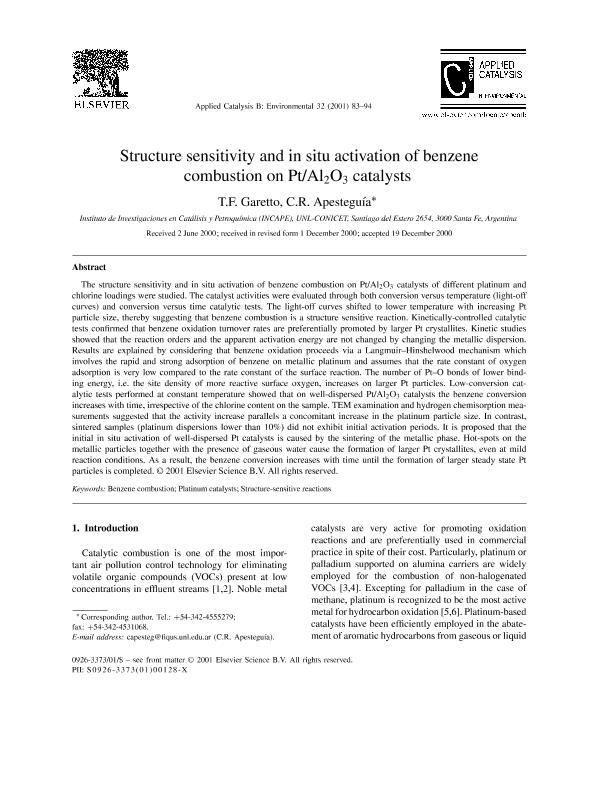Mostrar el registro sencillo del ítem
dc.contributor.author
Garetto, Teresita Francisca

dc.contributor.author
Apesteguia, Carlos Rodolfo

dc.date.available
2018-02-23T20:29:16Z
dc.date.issued
2001-01
dc.identifier.citation
Garetto, Teresita Francisca; Apesteguia, Carlos Rodolfo; Structure sensitivity and in-situ activation of benzene combustion on Pt/Al2O3 catalysts; Elsevier Science; Applied Catalysis B: Environmental; 32; 1-2; 1-2001; 83-94
dc.identifier.issn
0926-3373
dc.identifier.uri
http://hdl.handle.net/11336/37071
dc.description.abstract
The structure sensitivity and in situ activation of benzene combustion on Pt/Al2O3 catalysts of different platinum and chlorine loadings were studied. The catalyst activities were evaluated through both conversion versus temperature (light-off curves) and conversion versus time catalytic tests. The light-off curves shifted to lower temperature with increasing Pt particle size, thereby suggesting that benzene combustion is a structure sensitive reaction. Kinetically-controlled catalytic tests confirmed that benzene oxidation turnover rates are preferentially promoted by larger Pt crystallites. Kinetic studies showed that the reaction orders and the apparent activation energy are not changed by changing the metallic dispersion. Results are explained by considering that benzene oxidation proceeds via a Langmuir–Hinshelwood mechanism which involves the rapid and strong adsorption of benzene on metallic platinum and assumes that the rate constant of oxygen adsorption is very low compared to the rate constant of the surface reaction. The number of PtO bonds of lower binding energy, i.e. the site density of more reactive surface oxygen, increases on larger Pt particles. Low-conversion catalytic tests performed at constant temperature showed that on well-dispersed Pt/Al2O3 catalysts the benzene conversion increases with time, irrespective of the chlorine content on the sample. TEM examination and hydrogen chemisorption measurements suggested that the activity increase parallels a concomitant increase in the platinum particle size. In contrast, sintered samples (platinum dispersions lower than 10%) did not exhibit initial activation periods. It is proposed that the initial in situ activation of well-dispersed Pt catalysts is caused by the sintering of the metallic phase. Hot-spots on the metallic particles together with the presence of gaseous water cause the formation of larger Pt crystallites, even at mild reaction conditions. As a result, the benzene conversion increases with time until the formation of larger steady state Pt particles is completed.
dc.format
application/pdf
dc.language.iso
eng
dc.publisher
Elsevier Science

dc.rights
info:eu-repo/semantics/openAccess
dc.rights.uri
https://creativecommons.org/licenses/by-nc-sa/2.5/ar/
dc.subject
Benzene Combustion
dc.subject
Platinum Catalysts
dc.subject
Structure-Sensitive Reactions
dc.subject.classification
Otras Ingeniería Química

dc.subject.classification
Ingeniería Química

dc.subject.classification
INGENIERÍAS Y TECNOLOGÍAS

dc.title
Structure sensitivity and in-situ activation of benzene combustion on Pt/Al2O3 catalysts
dc.type
info:eu-repo/semantics/article
dc.type
info:ar-repo/semantics/artículo
dc.type
info:eu-repo/semantics/publishedVersion
dc.date.updated
2018-02-21T21:41:50Z
dc.journal.volume
32
dc.journal.number
1-2
dc.journal.pagination
83-94
dc.journal.pais
Países Bajos

dc.journal.ciudad
Amsterdam
dc.description.fil
Fil: Garetto, Teresita Francisca. Consejo Nacional de Investigaciones Científicas y Técnicas. Centro Científico Tecnológico Conicet - Santa Fe. Instituto de Investigaciones en Catálisis y Petroquímica ; Argentina
dc.description.fil
Fil: Apesteguia, Carlos Rodolfo. Consejo Nacional de Investigaciones Científicas y Técnicas. Centro Científico Tecnológico Conicet - Santa Fe. Instituto de Investigaciones en Catálisis y Petroquímica ; Argentina
dc.journal.title
Applied Catalysis B: Environmental

dc.relation.alternativeid
info:eu-repo/semantics/altIdentifier/doi/https://doi.org/10.1016/S0926-3373(01)00128-X
dc.relation.alternativeid
info:eu-repo/semantics/altIdentifier/url/https://www.sciencedirect.com/science/article/pii/S092633730100128X
Archivos asociados
